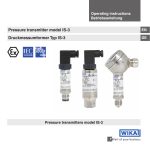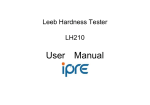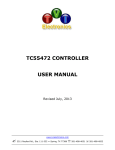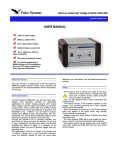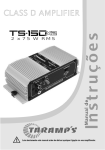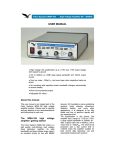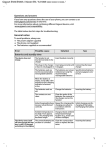Download Broadband High Voltage Booster HVB 300 for Alpha
Transcript
T.E.I. ΣΤΕΡΕΑΣ ΕΛΛΑΔΑΣ ΤΜΗΜΑ ΗΛΕΚΤΡΟΝΙΚΩΝ ΜΗΧΑΝΙΚΩΝ ΤΕ ΕΡΓΑΣΤΗΡΙΟ «ΗΛΕΚΤΡΟΝΙΚΕΣ ΔΙΑΤΑΞΕΙΣ ΦΑΣΜΑΤΟΣΚΟΠΙΑΣ» ΕΡΓΑΣΤΗΡΙΑΚΗ ΑΣΚΗΣΗ 3: “EΓΚΑΤΑΣΤΑΣΗ – ΛΕΙΤΟΥΡΓΙΑ- ΧΡΗΣΗ ΔΙΑΤΑΞΗΣ ΔΗΛΕΚΤΡΙΚΗΣ ΦΑΣΜΑΤΟΣΚΟΠΙΑΣ ΥΨΗΛΩΝ ΤΑΣΕΩΝ ΠΟΛΩΣΗΣ” Α.ΚΑΝΑΠΙΤΣΑΣ Καθηγητής ΛΑΜΙΑ 2013 Στην παρούσα εργαστηριακή άσκηση θα μελετηθεί ο τρόπος εγκατάστασης, η υλοποίηση της κατάλληλης συνδεσμολογίας και η λειτουργία της διάταξης Διηλεκτρικής Φασματοσκοπίας Novocontrol Alpha Broadband High Voltage Booster. Παρατίθενται παρακάτω οδηγίες και τεχνικά χαρακτηριστικά απο το εγχειρίδιο χρήσης της διάταξης. Broadband High Voltage Booster HVB 300 for Alpha-A High Resolution Dielectric / Impedance Analyzer User's Manual Issue: 2/2008 Rev. 1.01 by Novocontrol Technologies Novocontrol Technologies GmbH & Co. KG Obererbacher Strasse 9 D-56414 Hundsangen Germany Phone: FAX: Email: WWW ++(0) 64 35 - 96 23-0 ++(0) 64 35 - 96 23-33 [email protected] http://www.novocontrol.de Broadband High Voltage Booster HVB 300 for Alpha-A Analyzer User's Manual Copyright @ Novocontrol Technologies GmbH & Co. KG 2004 Germany _______________________________________________________________________________________________ 2 Broadband High Voltage Booster HVB 300 for Alpha-A Analyzer User's Manual Contents 1. Safety Precautions .............................................................................................4 2. Inspection............................................................................................................6 3. Introduction.........................................................................................................6 4. Instrument Description ......................................................................................7 4.1. Front Panel .......................................................................................................7 4.2. Rear Panel .......................................................................................................9 5. Novocontrol High Voltage Sample Cell BDS 1200HV ...................................13 6. Setting up the System for Measurement........................................................17 6.1. System Requirements ...................................................................................17 6.2. System Connections for High Voltage Measurements ...............................18 7. Principle of Operation ......................................................................................20 8. Using DC-Bias...................................................................................................23 9. Breakdown, High Frequency and Load Considerations...............................24 10. Calibrations .......................................................................................................25 11. Operating the Alpha-A with HVB 300 by GPIB commands...........................29 12. Technical Data ..................................................................................................31 13. Test Sample Results ........................................................................................33 _______________________________________________________________________________________________ 3 Broadband High Voltage Booster HVB 300 for Alpha-A Analyzer User's Manual 1. Safety Precautions The following safety precautions should be read carefully before using this product. Before connecting the line power cord to the HVB 300 : • Carefully read the HVB 300 manual. Contact Novocontrol in case of anything unclear. Operation without having read the manual or by not qualified operators is prohibited. • Connect the HVB 300 additional permanent Protective Earth PE Contact to a protective earth contact of your line power net. This connection provides a second protective earth wire in addition to the standard protective earth wire of the line power cord. Refer to "Rear Panel, Protective Earth" for details. Before switching any instruments on : • Make sure that the line power voltage indicated on the HVB 300 rear matches the actual voltage of your power line. Caution : Operating the HVB 300 at incorrect line voltage may result in permanent device damage, possibly voiding warranty. • Make sure that the line power cord is connected only to a power line with protective earth contact. The grounding of any parts of the HVB 300 must not be broken. The HVB 300 power cord contains a separate ground wire for only use with grounded power line outlets. When proper connections are made, the instrument chassis is connected to the power ground line by the power cord ground wire. Warning: Failure of this connection may result in personal injury or death due to electric shock. • The Sample HV1 and Sample HV4 SHV sockets of the high voltage interface, the sample cell connection cables, the two sample cell SHV sockets 1 and 4, inner parts of the sample cell like e.g. electrode wires and electrodes may be at high voltage up to +-150 Vp. Warning: Touching this voltage may result in personal injury or death due to electric shock. • If you intend to control the Alpha-A analyzer in combination with the HVB 300 by own GPIB programs, refer to the "Operating the Alpha-A with HVB 300 by GPIB commands" chapter for additional safety considerations. • Set up all cable connections as described in the "Setting up the System for Measurement" chapter. _______________________________________________________________________________________________ 4 Broadband High Voltage Booster HVB 300 for Alpha-A Analyzer User's Manual • Do not exceed the maximum voltage or current limits specified in the "Instrument Description" chapter for any connectors and sockets. Caution: Exceeding the specified limits may result in permanent device failure. • There are no parts inside the HVB 300 which require maintenance or adjustments. Therefore the instrument should not be opened. In any case remove the power cord and any test cables before opening the case or removing any parts from the case. Warning : Opening the case or removing parts may expose conductors at high lethal voltages if the HVB 300 is connected to the power supply. Even if the instrument is disconnected from line power, internal capacitors may still be charged at high voltage up to 500 Vpp. • To clean the instrument, use a damp cloth or mild, water based cleaner. Clean the exterior of the instrument only. Do not apply cleaner directly to the instrument or allow liquids to enter or spill the instrument. After having switched on the HVB 300 and the Alpha-A mainframe: Before operating the system always make sure that the device code ALPHA + HVB 300 is displayed at the Alpha mainframe after power on or reset. Warning: If other device codes as "ALPHA + HVB 300" are displayed, switch off the HVB 300 and Alpha-A mainframe and check the system set-up. System operation in this state is not allowed and may result in unexpected high voltages at the 300Vpp Out terminal. _______________________________________________________________________________________________ 5 Broadband High Voltage Booster HVB 300 for Alpha-A Analyzer User's Manual 2. Inspection The HVB 300 was tested and mechanically inspected before shipment. After unpacking, inspect all items for obvious physical damage. Report any damage to Novocontrol Technologies immediately. Save the original packing in order to prove damage that may have occurred during transit. The Broadband HVB 300 for the Alpha-A analyzer includes the following items : • HVB 300 mainframe • High voltage test sample 100 pF • High voltage test sample RC network • Load short calibration standard • Line power cable • 2 high voltage cables 1 m with SHV (save high voltage) connectors • 3 BNC cable 25 cm • HVB 300 user's manual 3. Introduction The HVB 300 is a device for extending the voltage range of the Novocontrol Technologies Alpha-A High Resolution Dielectric-Impedance Gain Phase Analyzer. The Alpha-A can be operated in combination with the HVB 300 or with other test interfaces. See "System Connections" or the Alpha-A user manual for more. With the HVB 300 connected, the system can create up to +-150 Vp ac and / or dc bias voltage at the sample. The ac frequency range is from 3 µHz .. 1 HMz. The maximum current is about 70 mA. The output impedance is 200 Ω. The system can measure both samples with high impedance up to 1015 Ω and low impedance down to 0.1 Ω. For samples with impedance < 2 kΩ, the output voltage will decrease due to the 200 Ω output impedance. Refer to "Breakdown, High Frequency and Load Considerations" for details. The Alpha-A in combination with the HVB 300 can be operated either by the Novocontrol WinDETA software or by internal Alpha GPIB commands. For details refer to the WinDETA manual, the Alpha manual and "Operating the Alpha-A with HVB 300 by GPIB commands". _______________________________________________________________________________________________ 6 Broadband High Voltage Booster HVB 300 for Alpha-A Analyzer User's Manual 4. Instrument Description 4.1. Front Panel Main Power Switch SHV Sockets Vout Voltage Indicator BNC Sockets novocontrol -150 Mains 0 150 Vout [Vp] Sample HV1 300 Vpp Out GEN Sample HV4 Current In V1 V2 HIGH VOLTAGE BOOSTER Fig. 4.1.1 : HVB 300 front panel. The front panel contains the following elements. The Main Power Switch applies line power to the HVB 300. Caution: Before switching on make sure • that the line voltage indicated at the HVB 300 rear line power connector matches your actual line voltage; • that all cable connections are properly established as described in "System Connections". The HVB 300 power cord contains a separate ground wire for only use with grounded outlets. When proper connections are made, the instrument chassis is connected to the power ground line by the power cord ground wire. Warning: Failure of this connection may result in personal injury or death due to electric shock. The Vout Voltage Indicator displays the peak voltage applied to the 300 Vpp Out socket by a LED bar graph. • The GEN socket has to be connected to the Alpha-A analyzer GEN socket. GEN is internally connected to the internal voltage amplifier input. 1.92 V input voltage at GEN will result in approx. 150 V output voltage at 300 Vpp Out. • The V1 socket has to be connected to the V1 socket of the Alpha-A mainframe. _______________________________________________________________________________________________ 7 Broadband High Voltage Booster HVB 300 for Alpha-A Analyzer User's Manual V1 supplies a fraction of the 300 Vpp Out voltage created by an internal voltage divider. The maximum voltage at this pin is 4.5 Vp ac or / and dc. This output is short protected to system ground. Do not apply any external voltages or currents. • The V2 socket has to be connected to the V2 socket of the Alpha-A mainframe. V2 provides the voltage output of the HVB 300 internal current to voltage converter. This output is short protected to system ground. Do not apply any external voltages or currents. • The 300 Vpp Out SHV socket has to be connected to signal source input of the Novocontrol BDS 1200HV high voltage sample cell or to any other sample impedance under test as the voltage source. 300 Vpp Out is internally connected via a 200 Ω resistor and a voltage activation switch to the internal high voltage amplifier output. The maximum output voltage is about +-150 V ac and / or dc. The current is limited to about 70 mA. The output impedance is 200 Ω. This output is short protected to system ground. Do not apply any external voltages or currents. Caution: Connecting the 300 Vpp Out to any of the GEN, V1 or V2 sockets may result in permanent damage of the instrument. • The Current In SHV socket has to be connected to the current output of the Novocontrol BDS 1200HV high voltage sample cell or to any other sample impedance under test as the current sense. Current In is internally connected via an activation switch to the HVB 300 internal current amplifier. The maximum current is about +-70 mA ac and / or dc. If Current In is internally connected, it will be at low impedance and with this at nearly zero potential. If Current In is internally disconnected, it will be at high impedance (open). In this case, Current In may be at the same potential as the 300 Vpp Out socket if connected via a sample or sample cell. The Current In socket input is protected against short circuits to the 300 Vpp Out socket. Warning: Touching the voltage at the 300 Vpp Out or Current In sockets may result in personal injury or death due to electric shock. Note: The cable connection between the 300 Vpp Out and Current In socket must have low capacity. Use only the original 1 m SHV cable supplied by Novocontrol. _______________________________________________________________________________________________ 8 Broadband High Voltage Booster HVB 300 for Alpha-A Analyzer 4.2. User's Manual Rear Panel CE Protective Earth Alpha-A Active Sample Cell Enable Vout 1A 230V 50-60Hz Additional Permanent PE Contact Alpha-A Active Sample Cell Connector High Voltage Output Enable Switch Line Power Fuse Line Power Connector Fig. 4.2.1 : HVB 300 rear panel. The rear panel contains the following elements : Additional permanent Protective Earth contact. This is a second protective earth connector (PE). The standard (first) PE connection is done by the PE wire of the line power cord. As the HVB 300 internally builds up voltages up to 500 Vpp, for safety reasons a second PE connection should be established which grounds the instrument in case of failure of the standard power cord PE wire. For this purpose the additional Protective Earth Contact should be connected by a separate ground wire permanently to the protective earth potential of the building line power net. An example is shown below. _______________________________________________________________________________________________ 9 Broadband High Voltage Booster HVB 300 for Alpha-A Analyzer User's Manual Building Line Power Supply PE Protective Earth 0V 220V ac Internal Building Connections Building PE Contact Additional Permanent PE Connection To High Voltage Booster Protective Earth Contact Building Line Power Plug Standard Line Power Cable To High Voltage Booster Line Power Connector Fig. 4.2.2 : Connection scheme of the HVB 300 line power cable and the additional permanent Protective Earth Contact to the building line power net. Alpha-A Active Sample Cell Connector. Connects the HVB 300 to the corresponding socket of the Alpha-A mainframe. Use only the 25 pin Sub-D cable supplied by Novocontrol. The cable provides a one to one connection for each of the 25 pins. Warning: This connector provides operating power and control voltages for the HVB 300. Do not connect any other devices to this terminal. Connecting other devices (like serial or parallel ports) may result in damage of devices. Enable Vout. Triggers an internal Enable Vout Switch which connects the HVB 300 internal high voltage amplifier output to the front panel 300 Vpp Out socket. If Enable Vout is left open, the 300 Vpp Out socket is internally disconnected from the high voltage amplifier. In order to connect the output, pins 1 and 2 of the Enable Vout socket must be connected by an external cable. The figure below shows the HVB 300 internal schematics of the Enable Vout Switch and the Enable Vout socket. Refer to "Principles of Operation" for additional details. _______________________________________________________________________________________________ 10 Broadband High Voltage Booster HVB 300 for Alpha-A Analyzer High Voltage Amplifier User's Manual Enable Vout Switch 1000 Vpp Out 12 V 2 1 Enable Vout Socket Fig. 4.2.3. HVB 300 internal Vout Enable system. In order to enable output voltage, connect pins 1 and 2 by an external wire. If the Novocontrol High Voltage Sample Cell is used, connect the HVB 300 Enable Vout socket by the cable supplied with the sample cell to the sample cell Enable Vout socket. In this case the 1000 Vpp Out socket will be only connected to the internal high voltage amplifier if the sample cell Enable Vout Switch is pressed. For details, refer to "High Voltage Sample Cell". Line Power Connector. Follow the procedure below to connect the HVB 300 to the line power. 1. Make sure that the line voltage indicated below the HVB 300 line power connector matches your actual line voltage. There is no option for changing the line voltage. If the line voltage does not match your actual line voltage, contact Novocontrol for replacement by another instrument. Caution : Operating the HVB 300 at incorrect line voltage may result in permanent device damage, possibly voiding warranty. 2. Do not switch the instrument on before connected to the line power. Do not switch the instrument on before all other connections described in "Setting up the System for Measurement" are established. 3. Connect the female end of the power supply cord to the HVB 300 Line Power Connector. 4. Connect the other end of the power cord to a grounded AC power line plug. The power cord contains a separate ground wire for only use with grounded outlets. When proper connections are made, the instrument chassis is connected to the power ground line by the power cord ground wire. Warning : Failure of this connection may result in personal injury or death due to electric shock. Line Power Fuse. The fuse protects the HVB 300 power cord. Generally, the fuse should not break except for internal malfunction. Therefore in case of break, it is strongly recommended to contact Novocontrol for support. If the fuse has to be replaced, proceed as follows. _______________________________________________________________________________________________ 11 Broadband High Voltage Booster HVB 300 for Alpha-A Analyzer User's Manual 1. Switch the instrument off. Disconnect the power cord first from the line power and than from the HVB 300 Line Power Connector. 2. Replace the fuse by the following type : 1A, slow blow for line voltage 220V-240V _______________________________________________________________________________________________ 12 Broadband High Voltage Booster HVB 300 for Alpha-A Analyzer User's Manual 5. Novocontrol High Voltage Sample Cell BDS 1200HV Lower Electrode SHV Connector HV4 Enable Vout Connector Upper Electrode SHV Connector HV1 PT100 Connector Enable Vout Switch Sample Mounting Screw Electrode Connectors Isolation Housing Lower Electrode (AC/DC Signal Source) Lower Cell Fixing Screw Upper Electrode (Current Sense) PT100 Temperature Sensor Fig. 5.1: High Voltage Sample Cell The High Voltage Sample Cell contains the following elements : Lower Electrode SHV Connector The inner contact of this Save High Voltage connector is connected to the lower sample electrode. The outer contact is connected to the cell case. This socket should be connected by a SHV BNC cable to the signal source. For the HVB 300 this is the 300 Vpp Out socket. Upper Electrode SHV Connector The inner contact of this Save High Voltage connector is connected to the upper sample electrode. The outer contact is connected to the cell case. This socket should be connected by a SHV BNC cable to the current sense of the impedance measurement instrument. For the HVB 300 this is the Current In socket. _______________________________________________________________________________________________ 13 Broadband High Voltage Booster HVB 300 for Alpha-A Analyzer User's Manual Enable Vout Connector and Enable Vout Switch They are internally in the cell connected are as shown below. Cell Enable Vout Switch Not Pushed Position (Cell not mounted in Cryostat) Cell Enable Vout Connector Fig. 5.2: Cell Internal Enable Vout Switch and Connector scheme. The purpose of the Enable Vout Switch is to disable the high voltage signal source output if the cell is not immersed in a surrounding cryostat or shielding unit. In this case the switch is in the not pushed position. If the cell is immersed in the cryostat, the switch changes to the pushed position. For the HVB 300 the sample cell Enable Vout socket should be connected to the HVB 300 Enable Vout socket. In this case, the HVB 300 will only apply voltage to the 300 Vpp Out socket if the Enable Vout Switch is pushed (cell immersed into cryostat). PT100 Connector This 4 wire connector can be used for sensing the sample temperature. This is done with a PT100 temperature sensor mounted in the Lower Electrode plate. The PT100 is connected as shown below. Fig. 5.3: PT100 temperature connector of the high voltage sample cell. _______________________________________________________________________________________________ 14 Broadband High Voltage Booster HVB 300 for Alpha-A Analyzer User's Manual Upper Electrode The sample should be mounted between the Upper and Lower Electrode. For details of sample preparation and mounting refer to the "Sample Preparation and Measurement Accuracy" chapter of the Alpha-A analyzer manual. The Upper Electrode senses the sample current, the Lower Electrode applies the voltage to the sample. Lower Electrode Applies the signal generator output voltage to the sample material. The sample cell lower part containing the sample capacitor can be separated as shown below. This eases handling during the sample preparation and allows cell usage with various lower samples cells. Upper Sample Cell Lower Cell Fixing Screw 2. Move Horizontally Electrode Connectors 1. Move Vertically Sample Mounting Screw Lower Sample Cell PT100 Temperature Sensor Lower Electrode PT100 Temperature Sensor Fig. 5.4: Procedure of separating the lower sample cell from the upper cell. In order to separate the Lower Sample Cell from the Upper Sample Cell : • Loosen the Lower Cell Fixing Screw. • In a first step, slowly move the lower sample cell vertically to the upper sample cell as shown in fig. 5.4. While moving stepwise, pull the both Electrode Connectors out of the connection lines. The PT100 Sensor remains in the lower electrode at this time and shifts itself out of the upper sample cell. The PT100 can be shifted vertically by about 5 cm with respect to the upper sample cell, but can not be disconnected from the upper sample cell. Caution: Do not pull to strong. Otherwise the PT100 connections maybe damaged. • In a second step move the lower sample cell horizontally in order pull the PT100 sensor out of the Lower Electrode. _______________________________________________________________________________________________ 15 Broadband High Voltage Booster HVB 300 for Alpha-A Analyzer User's Manual Important : If the lower sample cell has to be re-mounted after separation, connect the upper electrode to the thicker line of the upper sample cell and the lower electrode to the thinner line. The connections must not be exchanged. In order to measure a sample, it must be build into the sample capacitor. For this purpose, the sample should not directly be placed between the electrodes of the sample cell. Instead, it should be placed between two disposable electrodes as shown in fig. 5.6. Disposable electrodes are available from Novocontrol in various diameters. D Sample Material Disposable Electrodes d Silica Spacers Fig. 5.6: Sample capacitor prepared with two round disposable plate electrodes. The two electrodes with the sample between can be seen as a separate sample capacitor which can be placed between the active sample cell electrodes as shown in fig. 5.7. This procedure simplifies the sample preparation, protects the electrodes from contamination and allows to remove the sample easily. Electrode Connectors Critical Electrical Connections Sample Mounting Screw Isolation Housing Screw Upper Cell Electrode Disposable Electrodes Sample Material Lower Cell Electrode Fig. 5.7: Lower sample cell part with sample mounted between disposable electrodes. Important • Use the Sample Mounting Screw in order to fix the Disposable Electrodes by the Upper Cell Electrode. • Do not use the Insulation Housing Screw in order to fix the sample. This may result in improper contact and damage of the upper electrode isolation. • Before starting a measurement check the Critical Electrical Connections for proper contact. • Tighten to the Upper Cell Electrode by rotating it clockwise against the Isolation Housing Screw until a fix connection is established. _______________________________________________________________________________________________ 16 Broadband High Voltage Booster HVB 300 for Alpha-A Analyzer User's Manual • Tighten the screw of the Lower Cell Electrode connection wire with screw driver until a fix connection is established. • Check the two Electrode Connectors for proper contact with the upper sample cell connection lines. • From time to time, all four Critical Electrical Connections contacts should be cleaned and polished in order to remove insulating oxide layers. This applies especially if the cell was exposed to high temperatures before. For this purpose : • Remove the Upper Cell Electrode by rotating it anti clockwise against the Isolation Housing Screw, • Remove the Lower Cell Electrode connection wire by unscrewing it from the Lower Cell Electrode, • Pull the two electrode connectors out of the upper sample cell connections lines. For additional sample preparation hints, refer to "Sample Preparation" in the Alpha analyzer manual. 6. Setting up the System for Measurement 6.1. System Requirements You must have the following components in order to operate the HVB 300 in combination with an Alpha-A analyzer. • A Novocontrol HVB 300. • An Novocontrol Technologies Alpha-A High Resolution Dielectric Analyzer. • For dielectric material measurements a suitable sample cell is required. The Novocontrol High Voltage Sample Cell is recommended. The system has to be operated under control of a separate host computer by the GPIB IEEE 488 bus and an additional software package. You can either use standard software from Novocontrol or own written software. If you intend to control the Alpha-A in combination with the HVB 300 by own software, refer to the "Operating the Alpha-A with HVB 300 by GPIB commands" chapter. The following components are required. • A standard software development tool like e.g. a Basic interpreter or C compiler. _______________________________________________________________________________________________ 17 Broadband High Voltage Booster HVB 300 for Alpha-A Analyzer • User's Manual A host computer with an GPIB IEEE 488 interface port. The computer and the IEEE 488 interface must match to the software development tool. The Novocontrol WinDETA / WinIMP software supports dielectric and impedance measurements with optional support of temperature control. You must have the following components in order to operate the Alpha-A in combination with the HVB 300 by WinDETA or WinIMP. • The WinDETA or WinIMP software package from Novocontrol. • Either a Novocontrol GPIB card or a National Instruments GPIB card which matches your MS-Windows system for remote control of the Alpha analyzer. • An IBM compatible PC with a 486 or higher processor with at least 16 MB memory and MSWindows95, 98 or NT operating system. A PC with a Pentium processor is recommended. • If temperature control for the sample cell (Alpha-A + HVB 300 in combination with a Novocontrol High Voltage Sample Cell) is required : The Novocontrol WinDETA software, a Novocontrol temperature control system based on the QUATRO, Novocool, or Novotherm controller or another temperature control system based on an Eurotherm 818 or 2400 series temperature controllers. 6.2. System Connections for High Voltage Measurements In order to set up the Alpha-A analyzer in combination with the HVB 300 for a dielectric material or impedance measurement, the following connections have to done. Caution : Before setting up any connections : • Switch off the HVB 300 and all devices connected to it. • Switch off the Alpha-A analyzer and all devices connected to it. • Set up all connections as described in the "Rear Panel" chapter. • Respect the voltage and current limitations described in the "Front Panel" chapter. _______________________________________________________________________________________________ 18 Broadband High Voltage Booster HVB 300 for Alpha-A Analyzer User's Manual novocontrol -150 Mains 0 Sample HV1 300 Vpp Out 150 Vout [Vp] GEN V1 Sample HV4 Current In V2 HIGH VOLTAGE BOOSTER ALPHA + HVB 300 V4.3ANB IEC=10 Novocontrol Technologies Sample HI GEN Sample LO V1 Curr. OUT V2 HIGH RESOLUTION DIELECTRIC ANALYZER To Enable Vout at High Voltage Booster Rear Side HV4 Enable Vout HV1 PT100 Enable Vout Switch Novocontrol BDS 1200 Sample Cell PT100 Temperature Sensor Upper Electrode (Current Sense) Lower Electrode (AC Signal Source) Fig. 6.2.1 : Connections of combination Alpha-A and HVB 300 to the Novocontrol High Voltage Sample Cell. Instead of the dielectric sample cell, any impedance of interest maybe connected between the 300 Vpp Out and Current In terminals. In addition, the connections described in the "Rear Panel" chapter are required. Note : If the Novocontrol High Voltage Sample Cell is used, make sure that the HVB 300 Current In input is connected to the upper sample cell electrode (sample cell terminal HV4). This electrode is better isolated than the lower one. Do not touch the electrodes while the instrument is measuring. For proper operation, the sample cell has to be shielded. This is _______________________________________________________________________________________________ 19 Broadband High Voltage Booster HVB 300 for Alpha-A Analyzer User's Manual generally done by placing it into a grounded metal cryostat or a metal shielding tube. Both are available by Novocontrol. Warning: The 300 Vpp Out and Current In sockets may be at high voltage up to +-150 Vp ac and / or dc. In addition high voltage may be at the sample cell electrodes, electrode connection wires and the lines inside the sample cell. Touching any of those conductors may result in personal injury or death due to electric shock. The system may now be switched on. It is recommended to first switch the HVB 300 on and then the Alpha-A mainframe. The Alpha-A mainframe should after about 10 seconds show in its display the following boot message. ALPHA + HVB 300 V4.3ANB Novocontrol Technologies IEC=10 which indicates that the HVB 300 was properly detected by the mainframe. Before operating the system always make sure that the device code ALPHA + HVB 300 is displayed after power on or reset. Warning: If other device codes as "ALPHA + HVB 300" are displayed, switch off the system and check the set-up. System operation in this state is not allowed and may result in unexpected high voltages at the 300 Vpp Out terminal. 7. Principle of Operation The principal setup of the high voltage system is shown below. _______________________________________________________________________________________________ 20 Broadband High Voltage Booster HVB 300 for Alpha-A Analyzer User's Manual Sample Impedance Internal Connection Voltage Indicator High Voltage Booster Enable Vout Reference Capacitor *78 300 Vpp Out Current In System Ground (PE) 200 Ω /78 Voltage Divider GEN V1 V2 I->V Converter GEN Alpha-A Analyzer V1 V2 Fig. 7.1 : Principle schematic of the Alpha-A analyzer in combination with the HVB 300. The internal Alpha-A ac generator (at GEN) creates an ac voltage in the range 0 V .. 1.92 Vp. The signal maybe superimposed by an additional dc bias from -1.92 V .. 1.92 V. Both signals are limited by software, so that the total voltage at the GEN socket does not exceed +-1.92 Vp. The GEN signal is externally connected via the HVB 300 GEN socket to the high voltage amplifier and increased by a factor ~78. The maximum output voltage which may contain both ac and dc contributions is +-150 Vp. The amplifier current is limited to +-70 mA. The output impedance is adjusted to 200 Ω by an output resistor. This signal is applied via the internal Enable Vout Safety Switch to the 300 Vpp Out socket. The Enable Vout Safety Switch is normally open and in this state the output voltage is disabled. In operating mode, the Enable Vout Safety Switch has to be closed by applying an external connection to the Enable Vout Connector at the HVB 300 rear. Refer to "Rear Panel" and "High Voltage Sample Cell" for details. _______________________________________________________________________________________________ 21 Broadband High Voltage Booster HVB 300 for Alpha-A Analyzer User's Manual The output voltage peak amplitude at the 300 Vpp Out socket is displayed by the Voltage Indicator. The 300 Vpp Out signal is further applied to the Voltage Divider, reduced by a factor ~78 and applied via the two V1 sockets to the Alpha input voltage Channel 1. The 300 Vpp Out signal is applied in addition either to the the internal variable Reference Capacitor or the Sample Impedance. The sample current is sensed by the Current In socket. The reference capacitor or the sample can be connected by two internal switches to the HVB 300 current input. The current input has low impedance and therefore is nearly at ground potential. The sample or reference current is converted by the I -> V Converter into a voltage which is measured by the analyzer voltage Channel 2. Refer to the Alpha manual for further details on voltage measurement, sine wave correlation technique, current to voltage conversion, impedance measurement and reference technique. _______________________________________________________________________________________________ 22 Broadband High Voltage Booster HVB 300 for Alpha-A Analyzer User's Manual 8. Using DC-Bias In the high voltage mode with HVB 300 connected, the system allows to add an additional dc bias voltage Ub to the ac signal of the high voltage amplifier. It is applied to the sample as shown below. Bias Generator Sample Capacitor Amplifier Current to Voltage Converter Generator Ro Bias Voltage Ub AC Voltage Ug U1 Vector Voltage Analyzer Ch1 Vector Voltage Analyzer Ch2 U2 Fig. 8.1 : Electrical set-up in the high voltage system with an additional bias voltage applied to the sample capacitor. The samples current IS is the sum of the of the bias current Ib caused by the sample dc resistance Rdc and the ac current I(f) caused by the sample impedance Z(f) at the actual frequency of the generator. If the amplifier output resistance Ro is neglected I S = Ib + I ( f ) = U Ub + g Rdc Z ( f ) In the high voltage system (Alpha-A + HVB 300), all signals are always dc coupled and no restrictions for the ratio Rdc to Z(f) or for Rdc apply. Nevertheless, the following problems may arise. • If the sample current exceeds about +-70 mA, it will be limited by the high voltage amplifier to this value. If Rdc is sufficiently low, the current limit will be completely driven by the bias current Ib. In this case no additional current will be left for the ac signal and the ac signal may drop to very small values probably causing noise in the measured data. E.g. for a dc bias of 100V and a sample resistance of 1 kΩ, the voltage at the sample will be limited due to the current limit to 1 kΩ * 70 mA = 70 V dc without a significant ac contribution. This situation can be avoided by decreasing the total voltage applied to the sample (Ub + Ug) until no current limitation applies anymore. • If a high dc bias voltage Ub and a small ac voltage Ug is selected, and in addition Rdc is comparable to Z(f), the bias current Ib will be high against the ac current I(f). As the current channel is dc coupled, I(f) will only give a small portion to the totally measured current Is and the accuracy may decrease. _______________________________________________________________________________________________ 23 Broadband High Voltage Booster HVB 300 for Alpha-A Analyzer • For Rdc low or comparable to the amplifier output resistance Ro = 200 Ω, the dc bias voltage at the sample Ubs will decrease with respect to the select bias voltage Ub according to U bs = U b • User's Manual Rdc Rdc + Ro For sufficiently low Rdc, considerable power maybe applied to the sample which may result in self heating. The power created by the dc bias voltage in the sample is 2 Ps = U bs Rdc E. g. for Ubs = 140 V and Rdc = 2 kΩ, Ps = 9.8 W. The ac impedance Z(f) may contribute additional heating power. Note: Both the ac voltage and dc-bias voltage applied to the sample are measured by the Alpha analyzer and can be displayed or saved by WinDETA software as the dependent variable "Measured AC Voltage" and "Measured Bias Voltage". Refer to the WinDETA manual "Dependent Variables" for details. In own GPIB programs, the Alpha commands ZEXTRE? and ZDCA? may be used, respectively. 9. Breakdown, High Frequency and Load Considerations Both for high frequency performance and for breakdown currents, the capacity of the connection cables in the path from the amplifier 300 Vpp Out socket to the sample is important. During operation, the cable capacity is charged by the high voltage amplifier like the sample itself. If in this situation a short or breakdown in the sample occurs, the energy stored in the cable capacity will be applied via the shorted sample to the system current input. As the breakdown usually happens within a very short time, a short but strong current peak of several amperes will be applied to the system current input. The current magnitude of the peak is not limited by the 200 Ω output impedance of the high voltage amplifier, but mainly depends on the total value of all line capacities from the high voltage amplifier output to the sample. The system with the original 1m High Voltage Connection Cables and the High Voltage Sample Cell is designed to withstand short circuit and breakdown currents without damage or degrading performance. Anyhow, significantly higher current peaks may damage the input current amplifier. Therefore, only the original high voltage cables delivered with the system should be used. If own cables are used, make sure the external cable total cable capacity in the high voltage path from the 300 Vpp Out socket to the sample does not exceed 150 pF. The maximum voltage available at the sample depends on the sample impedance Zs and the cable capacity. The cable impedance _______________________________________________________________________________________________ 24 Broadband High Voltage Booster HVB 300 for Alpha-A Analyzer Zc = − User's Manual j 2πf C c (f Frequency and Cc cable capacity) in parallel with Zs creates a load on the HVB 300 output resistance Ro which decrease the ac voltage Usample at the sample by a factor U sample Ug = Zl Zl + Ro with respect to the high voltage amplifier output voltage Ug. Zl is the total load impedance made up by a parallel circuit of Zs and the cable impedance Zc. In addition, for higher voltages, the current limit of about 70 mA of the high voltage amplifier may be reached. This will limit the voltage Ug of the high voltage amplifier (before the output resistor Ro) to U g max = 70mA Zl + Ro Example : At f = 1 MHz, a sample capacity of 100 pF and a cable capacity = 100 pF, Zl = -j 796 Ω ( j = −1 ). This will limit the maximum available amplifier voltage to about 55 Vp corresponding to 39 Vrms. The voltage at the sample will be further reduced by Ro by a factor U sample Ug = 796 796 2 + 200 2 = 0,96 At frequencies > 160 kHz, the available HVB 300 output voltage is further limited by internal amplifier slew rate to 300 Vpp at 160 kHz and 60 Vpp at 1 MHz with a linear decrease in between. Note : Both the ac voltage and the dc bias voltage applied to the sample are measured by the Alpha-A analyzer and can be displayed or saved by WinDETA software as the dependent variable "Measured AC Voltage" and "Measured Bias Voltage". Refer to the WinDETA manual "Dependent Variables" for details. In own GPIB programs, the Alpha commands ZEXTRE? and ZDCA? may be used, respectively. 10. Calibrations The following kinds of calibration should be done for the Alpha-A in combination with the HVB 300. _______________________________________________________________________________________________ 25 Broadband High Voltage Booster HVB 300 for Alpha-A Analyzer User's Manual 1. Internal Alpha All Calibration of the amplification and phase shifts of the HVB 300 impedance converter measurement ranges. -Disconnect the cables from the 300 Vpp Vout and Current In terminals before starting the calibration. -Make sure that the HVB 300 internal Enable Vout switch is closed. For details refer to "Rear Panel, Enable Vout". If you are using the High Voltage Sample Cell, place the cell into a cryostat or shielding unit in order close the Enable Vout switch. In order to start the calibration with WinDETA: -Make sure that in the WinDETA "Analyzers" menu, "Alpha + High Volt Amp. +- 150Vp" is selected as the actual impedance system. -Select "Calibrate BDC or Alpha All" from the WinDETA menu item "Analyzers, Options (Alpha + High Voltage Amp. +-150Vp). In order to start the calibration by own GPIB programs: -Use the GPIB commands *RST, ZRUNCAL=ALL_INIT and ZRUNCAL=ALL. This calibration should be done in intervals of approximately 4 weeks in order to compensate for long term drift effects. As low frequencies are involved, the calibration will run for about 25 minutes. 2. Internal Reference Calibration. This is a subset of the Alpha All Calibration and includes only calibrations of the ranges used in combination with reference capacitor measurements. This calibration should be done from time to time. Highest precision will be reached, if the calibration is done immediately before a measurement. -Disconnect the cables from the 150 Vpp Vout and Current In terminals before starting the calibration. -Make sure that the HVB 300 internal Enable Vout switch is closed. For details refer to "Rear Panel, Enable Vout". If you are using the High Voltage Sample Cell, place the cell into a cryostat or shielding unit in order close the Enable Vout switch. In order to start the calibration with WinDETA: -Make sure that in the WinDETA "Analyzers" menu, "Alpha + High Volt. Amp. +-150Vp" is selected as the actual impedance system. -Select "Calibrate BDC or ALPHA Reference" from the WinDETA menu item "Analyzers, Options (Alpha + High Voltage Amp. +-150Vp)". In order to start the calibration by own GPIB programs: _______________________________________________________________________________________________ 26 Broadband High Voltage Booster HVB 300 for Alpha-A Analyzer User's Manual -Use the commands *RST, ZRUNCAL=REF_INIT and ZRUNCAL=REF. 3. External Interface Low Impedance Load Short Calibration Calibrates the HVB 300 current to voltage converter ranges for sample impedance < 1 kΩ. In addition the properties of the sample connection lines and the sample cell are included. This calibration is only used for low impedance samples with impedance < 1 kΩ. It should be done in intervals of approximately 4 weeks in order to compensate for long term drift effects. The calibration requires an external 100 Ω resistor and a short calibration standard supplied with the HVB 300. Important: • The load short calibration measures low impedance below 0.1 Ω. It is therefore required, that the contact resistance of the used cables and electrodes are reproducible within 0.1 Ω with respect to a later measurement. It is recommended to check the calibration, by re measuring the 100 Ω standard and the short standard after the calibration and check the measured result. • After the calibration was done make sure that it is activated by the “Use Low Impedance Load Short Calibration” switch of the WinDETA dialog “Analyzers, Options Alpha, Configuration”. Otherwise, the calibration data will be saved but not applied during measurements. • Before performing a Load Short Calibration, an All Calibration is recommended. • Make sure that the HVB 300 internal Enable Vout switch is closed. For details refer to "Rear Panel, Enable Vout". If you are using the High Voltage Sample Cell, place the cell into a cryostat or shielding unit in order close the Enable Vout switch. The calibration is started by the Alpha GPIB command sequences *RST, ZRUNCAL=SL_INIT, ZRUNCAL=SL_SHORT and ZRUNCAL=SL_100 or the WinDETA menu item "Analyzers, Options (Alpha Analyzer), “Alpha Load Short Calibration”. After starting the calibration you will be asked by WinDETA or by the Alpha display for the GPIB command set to connect the short and load calibration standards to the HVB 300 as shown below. _______________________________________________________________________________________________ 27 Broadband High Voltage Booster HVB 300 for Alpha-A Analyzer 100Ω to 300Vpp Out Short to Current In Short Calibration Configuration User's Manual 100Ω to Current In Short to 300Vpp Out Load Calibration Configuration Fig. 9.1 : Short / Load calibration configurations for the HVB 300 interface. 4. Optional low capacity open calibration With the HVB 300 connected, this calibration has the same effect as the corresponding low capacity open calibration for the other Alpha-A lower voltage test interfaces. Refer to the Alpha manual for details. In order to do the calibration: -Disconnect the cables from the 150 Vpp Vout and Current In terminals before starting the calibration. -Make sure that the HVB 300 internal Enable Vout switch is closed. For details refer to "Rear Panel, Enable Vout". If you are using the High Voltage Sample Cell, place the cell into a cryostat or shielding unit in order close the Enable Vout switch. If you are using WinDETA: -Select in the "Analyzer" menu, "Alpha + High Volt. Amp. +-150Vp" for the actual impedance system. -Select "Alpha Low Capacity Open Calibration" from the WinDETA menu item "Analyzers, Options (Alpha + High Voltage Amp. +-150Vp). If you are using own GPIB programs: -Proceed as described in the Alpha-A manual "Low Capacity Open Calibration" for the Alpha-A analyzer. _______________________________________________________________________________________________ 28 Broadband High Voltage Booster HVB 300 for Alpha-A Analyzer User's Manual 11. Operating the Alpha-A with HVB 300 by GPIB commands Most of the commands are the same for operation of the Alpha-A analyzer with and without HVB 300 connected. Nevertheless, the following differences apply with the HVB 300 connected. -The MODE=VOLT command (gain phase mode) is not available and not allowed with the HVB 300 connected. -The ACV=, DCE= and MST commands are only available after a system connections test with the ZRUNCAL=CONCHECK command has been done. Details are described below. If the Alpha-A mainframe is connected to the HVB 300 by the 25 pin Sub-D cable as described in the "Rear Panel" chapter, the Analyzer will automatically enter the IMP_HV150 mode. For details refer to the MODE= command in the Alpha-A manual. As a result the Alpha will adjust its current and voltage ranges to the HVB 300. The ranges of the ACV= and DCV= commands which set the ac and dc voltage will be extended and the HVB 300 amplification ratio will be taken into account so that the commands can be used as usual. E.g. DCV=50 will set 50V dc bias voltage at the 300 Vpp Vout socket. On the other hand, the voltage at the GEN socket which acts as the voltage source for the HVB 300 will be about a factor 78 lower, which is the HVB 300 high voltage amplifier amplification. A similar situation applies for the V1 terminal which is driven by the output of the HVB 300 internal voltage divider and therefore by a factor 78 below the voltage at the 300 Vpp Vout terminal. Anyhow, the Alpha will internally correct for this and display the voltage at the 300 Vpp Vout terminal by internal multiplying the measured voltage at V1. This concept will work as long as the external device setup and cabling as described in "System Connections for Measurements" is correctly realized. On the other hand, problems may arise for an erroneous cabling setup different from the set-up described in the "System Connections for Measurements". Warning : With connected HVB 300 this may result in set-ups which may be either dangerous for the operator as unexpected high voltages may be applied to unexpected system parts or may damage the instrumentation by applying high voltage to low voltage terminals. In order to avoid such situations for the device combnation Alpha-A and HVB 300, the Alpha mainframe enters a special ZCON_TO_CHECK state =1 after power on or *RST where any output voltage at the GEN and 300 Vpp Vout terminals and the ACV=, DCV= and MST commands are disabled for safety reasons. In order to switch the Alpha in the ZCON_TO_CHECK = 0 state where the previous limitations do not apply, a system connections test for the actual selected mode is required. The system connections test should be started by the ZRUNCAL=CONCHECK command after the proper _______________________________________________________________________________________________ 29 Broadband High Voltage Booster HVB 300 for Alpha-A Analyzer User's Manual system setup was established as described in the "System Connections for Measurements" chapters. During the test a small voltage will be applied to the GEN socket which results in an not dangerous voltage at the 300 Vpp Vout socket if connected. The Alpha checks then the V1 and V2 terminals for proper voltages in order to make sure a proper system and cabling setup. If so, the system connections test is passed and ZCON_TO_CHECK state will change to 0 and the ACV=, DCV= and MST commands will be available. -The system connections test will be automatically applied at the beginning of any calibration started by the ZRUNCAL= command. -The system connections test is only required with the HVB 300 connected. The Alpha-A mainframe automatically detects the HVB 300 if connected by the 25 pin Sub-D cable as described in the "Rear Panel" chapter. _______________________________________________________________________________________________ 30 Broadband High Voltage Booster HVB 300 for Alpha-A Analyzer 12. User's Manual Technical Data Line voltage : 220 - 240 V ac, 50 - 60 Hz or 110 V ac, 50 - 60 Hz (see instrument rear) Power consumption : 50 W Environment Operating temperature : Storage temperature : Specification limits : 0° to 40°C -10° to 60°C 20° to 30°C Voltage Amplifier Output impedance 200 Ω Maximum output voltage 300 Vpp ac or dc for f > 160 kHz linear decrease in ac amplitude to 60 Vpp at 1 MHz Maximum output current about +-70 mA, protected against permanent short to system ground Frequency range DC to 1MHz. Voltage amplification Vout/Vin About 78 Voltage divider Voltage division Vout/V1 About 78 Current to voltage converter Frequency range 3 µHz .. 1 MHz Current ranges (rms) 40 mA, 15 mA, 1.5 mA, 150 µΑ, 15 µA, 1.5 µA, 150 nA, 15 nA, 1.5 nA, 150 pA, 15 pA, 1.5 pA Current resolution (reproducibility) +- 5 fA +-10-5 of current range _______________________________________________________________________________________________ 31 Broadband High Voltage Booster HVB 300 for Alpha-A Analyzer User's Manual +-30 fA/Hz * frequency of measurement Capacity range 10-15 - 0.01 F Resistance range 0.1 - 2.1015 Ω Accuracy in tan(δ) for capacitive samples: +- 3.10-5 +- 10-3 of measured value for frequency between 1 Hz .. 100 kHz and sample capacity between 50 pF .. 2 nF Reference capacitors 63 build in low loss precision reference capacitors from 25 pF .. 2 nF _______________________________________________________________________________________________ 32 Broadband High Voltage Booster HVB 300 for Alpha-A Analyzer Test Sample Results Novocontrol Test Sample Results AC Volt [Vrms]=70.00 100 10-1 0.8 10-2 0.6 10-3 0.4 0.0 10-4 0.2 Capacity Cp' [10-9F] 1.0 1.2 101 AC Volt [Vrms]=70.00 Tan(Delta) [] 13. User's Manual 10-3 10-2 10-1 100 101 102 103 104 105 106 107 105 106 107 Frequency [Hz] Novocontrol 100pF Test Sample AC Volt [Vrms]=70.00 10-6 10-7 60 10-3 Tan(Delta) [] 10-4 10-5 120 100 80 Capacity Cp' [10-12F] 140 10-3 10-2 160 AC Volt [Vrms]=70.00 10-2 10-1 100 101 102 103 104 Frequency [Hz] _______________________________________________________________________________________________ 33






































